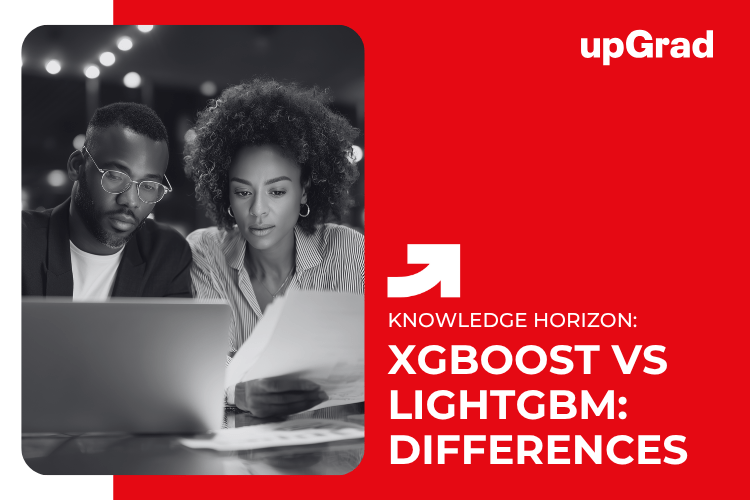Gradient boosting is a robust machine learning method that combines weak learners to build improved predictive models. It contributes to lower errors and higher accuracy while being applicable across several tasks and data types. XGBoost and LightGBM are both well-known gradient-boosting algorithms. Hence, understanding the XGBoost vs. LightGBM debate will help you make an informed decision on choosing the right model.
It matters more in a scenario where 78% of global companies already use AI for their business, and 71% use generative AI in one business function (or more). More importantly, 92% plan to increase AI investments over the next three years, making it an opportune time if you’re looking to build a career as a machine learning engineer. On that note, let’s dive deeper into the differences between XGBoost and LightGBM.
XGBoost vs LightGBM: Understanding the Differences and Choosing the Right Tool
The table below highlights the key differences between LightGBM and XGBoost for a better understanding.
| Attribute | LightGBM | XGBoost |
| Tree Growth Strategy | Leaf-wise | Level-wise |
| Categorical Data Handling | Native support | Needs Preprocessing |
| Training Speed | Quicker with a histogram-based approach | Slower for bigger datasets |
| Overfitting Tendency | Higher without suitable tuning | Lower |
| Memory Usage | Lower | Higher |
| Hyperparameter Tuning | Vast options | Vast options |
| Parallel Processing | Supported | Supported |
Origins and Development
Tianqi Chen developed XGBoost at the University of Washington. The release took place as part of the Distributed Deep Machine Learning Community initiative. It is ideal for complex scenarios and datasets where robust generalization is necessary.
LightGBM is the brainchild of Microsoft Research and aims to deliver quicker and more effective gradient-boosting algorithms for big data. It has quicker training times and optimization for larger datasets.
Tree Growth Strategies
It is one of the key factors worth considering in the LightGBM vs XGBoost debate. The latter uses level-wise tree growth systems (horizontal), while the former has leaf-wise growth (vertical) methods.
Performance and Speed
LightGBM is quicker due to histogram-based data binning and leaf-wise growth models. It is ideal for larger datasets and for lowering memory usage. On the other hand, XGBoost is robust and can tackle complex data interactions. However, it may lead to longer training times.
Handling of Categorical Features
LightGBM has an in-built system for direct handling of categorical features without requiring one-hot encoding. It may help reduce memory usage and enhance efficiency simultaneously. XGBoost supports categorical feature handling via partitioning or one-hot encoding.
Hyperparameter Tuning and Flexibility
XGBoost comes with numerous hyperparameters for tuning, including Gamma, Lambda, and tree structure parameters. You can thus gain fine-grained control over learning speed and model complexity.
LightGBM offers similar choices, although it has some unique features-
- num_leaves (controls the number of leaves in the tree)
- bagging_fraction
Also Read: What is Predictive Analytics and Its Role in Business Strategies
Pros and Cons of XGBoost and LightGBM
Let’s take a look at the pros and cons of both gradient-boosting algorithms.
XGBoost-
Pros:
- High accuracy and top-class results in machine learning tasks or competitions.
- Includes L1 and L2 regularization to combat overfitting.
- Offers a broader range of parameters and customization choices for fine-tuning.
- There are insights into feature importance to help with model selection and interpretation.
- Trusted by leading data scientists across multiple programming languages.
Cons:
- Vulnerable to overfitting without proper tuning.
- Longer training time for larger datasets and computationally costly.
- Needs minute parameter tuning and may not work as well with high-dimensional and sparse data.
LightGBM-
Pros:
- Quicker training speed and better efficiency when tackling bigger datasets.
- Optimized for memory usage.
- Supports parallel GPU acceleration and processing for faster training.
- Histogram-based method and leaf-wise growth make it ideal for big data applications.
- Uses GOSS (gradient-based one-sided sampling) and other techniques for better feature selection.
Cons:
- May be vulnerable to overfitting without suitable tuning (for small to moderate datasets).
- Smaller community ecosystem than XGBoost, making it tougher to find solutions at times.
- Extensive parameter tuning is necessary to avoid overfitting, while added steps are a must for handling missing values.
Which one to choose? If you’re looking for high accuracy and robust approaches while working with tabular/structured data in manufacturing, medicine, finance, etc., go for XGBoost. On the other hand, when you require greater efficiency and speed with larger datasets, LightGBM is a more suitable option.
Also Read: Machine Learning Interview Questions & Answers for US
Advancing Your Machine Learning Skills with upGrad
upGrad is your one-stop solution for boosting valuable machine learning skills with specialized programs from leading institutions. These courses offer industry-ready curricula and hands-on learning opportunities to broaden your understanding of machine-learning algorithms, including LightGBM and XGBoost. upGrad also ensures dedicated guidance and support for learners, helping them advance their careers in the competitive US market and beyond.
Some popular Machine Learning AI programs available on upGrad:
- Post Graduate Certificate in Generative AI (E-Learning)
- Master of Science in Machine Learning & AI
- Executive Certificate in Generative AI for Leaders (E-Learning)
- Executive Diploma in Machine Learning and AI with IIIT-B
FAQs on XGBoost vs LightGBM
Q: What is the main difference between XGBoost and LightGBM?
Ans: The main difference lies in the methods for building trees. XGBoost has a level-wise or horizontal system of tree growth, while LightGBM has a leaf-wise or vertical system. The latter method often ensures quicker training.
Q: Which industries use XGBoost and LightGBM the most?
Ans: Some of the industries using these algorithms include:
- E-commerce
- Banking
- Finance
- Healthcare
- Manufacturing and Supply Chain
Q: How does LightGBM achieve faster training speeds?
LightGBM achieves quicker training speeds with its histogram-based splitting, leaf-wise tree growth, and parallel and GPU training features. GOSS and EFB (exclusive feature bundling) also contribute to its speed and efficiency.
Q: Are there scenarios where XGBoost outperforms LightGBM?
Ans: There may be scenarios where XGBoost surpasses LightGBM in terms of performance. The former is usually robust and ideal for production-scale usage owing to level-wise tree growth and regularization.
Q: Can I use both XGBoost and LightGBM together?
Ans: You can use both XGBoost and LightGBM together in a stacked ensemble if you want. Fusing their unique strengths may help you get improved performance for specific tasks.









